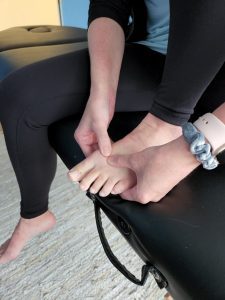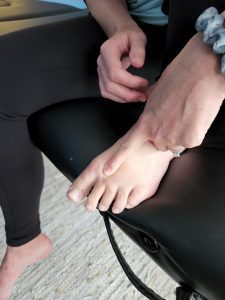Do you have a foot-shaped shoe or shoe-shaped foot?
Footwear was a great invention for humans long ago to protect our feet. But is modern-day footwear actually hindering how our feet function? Try this: find the shoes that you wear most often. If the insert comes out easily, take it out and stand on it. If any part of your foot hangs off the edges, chances are your shoes don’t actually fit properly.
Our feet have a natural splay at the toes (look at the feet of a baby who has recently started walking). Modern shoes will typically cause the foot to become compressed near the first knuckle of the toes. What is the problem with this? It limits how the bones move and how the normal arch of the foot functions. This compression and limited movement can cause pain points in not only the foot but also joints up the chain. Think knees, hips, lower back.
What should you look for in a shoe to prevent this?
More shoe companies are now making shoes with a functional toe box. This may look very wide (and strange) at first but you will notice your toes have room to move.
Look for a zero drop shoe as well. Zero drop means that the height of the sole is the same at the back of the shoe as it is at the front. Most “flat” shoes have a 5-10 mm rise at the heel. This small rise can cause chronic tightness of the Achilles tendon and calf muscles. A zero drop does not mean that there is no cushion. The shoe can still have cushion, but it is even at the front and back.
The shoes should also bend and twist easily in your hands. This should allow more natural movement of your foot.
This is simply general advice and not necessarily meant for every foot or to diagnose any specific condition. Of course, there are times and certain conditions that would require a more structured and supportive shoe. This might include fractures, neuropathies with altered or absent sensation, or severe structural deformities.
If you are already dealing with a “shoe-shaped foot,” try these techniques to decrease stiffness.
Metatarsal mobilizations
Grab the bone in your foot just above the knuckle with one hand then grab the one next to it with the other. Gently move up with one hand and down with the other. Repeat the opposite direction. You can do this with each toe. It is not a large amount of movement and will vary from toe to toe.
Intrinsic soft tissue mobilization
Press firmly with the tip of your finger between 2 bones in the top of your foot between each toe. Run up and down from toe to ankle. It may be quite tender. You can also use a pencil eraser.
Foot wringing
Interlace your fingers between each toe. With the other hand, hold your heel. Rotate your foot like you are wringing out a towel.
Follow us on Instagram (@anchorwellnesscincy) for more tips & for the reel of the above movements!
About the author:

Chelsea Walter, PT, DPT is a Doctor of Physical Therapy with a special interest on treatment of spinal conditions. She graduated from Saint Louis University in 2014 with her Doctorate of Physical Therapy and completed undergraduate work at the same institution. From 2018 to 2019, she was a post-graduate resident with the McKenzie Institute where she achieved certification in the McKenzie Method of Mechanical Diagnosis and Therapy (MDT) and board certification in orthopaedics (OCS). Chelsea enjoys working with clients who are active in the gym or with recreational sports. She has led an active lifestyle from early on in life and enjoys hiking, travel, and spending time with family.
Growing up with a mom who’s a fitness professional, exercise was a very normal part of her life. She spent her younger years going to the gym with her Mom and playing sports. As she grew older, she enjoyed volunteering her time to work with younger kids with disabilities introducing her to the world of physical therapy. It seemed to be the perfect fit for her. Once she was in PT school, she figured out she was better suited at working with teenagers and adults, and the rest is history.
Chelsea love treating clients with back and neck issues, especially when clients have tried a lot of other treatments without much success. She love working with clients who want to avoid more invasive procedures and are invested in their overall health.
Her mission is to keep people active and pain-free and spread the word about what the profession of physical therapy can do!




